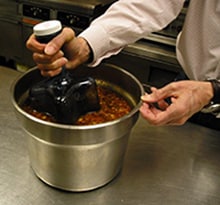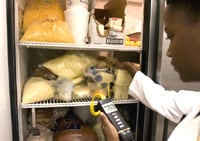Food Cooling Practice Improvements
Key Takeaways from 3 Food Safety Reports

Federal guidelines recommend several practices for cooling food, but not all restaurants follow them. Food safety programs and restaurants can improve cooling practices by
- Focusing intervention efforts on independent and smaller restaurants.
- Following the U.S. Food and Drug Administration’s (FDA) Food Code cooling guidelines.
- Encouraging or requiring kitchen managers to be certified in food safety.
Hot food needs to be cooled quickly to prevent foodborne illness outbreaks caused by germs. Ten years of data (1998 to 2008) show 504 outbreaks of foodborne illness in restaurants were caused by hot food cooled too slowly.

EHS-Net looked at food cooling practices in restaurants and published three articles on these practices.
- How cooling practices like cooling food depth, pan ventilation, and time and temperature monitoring are linked to how fast food cools.
- How restaurant and kitchen manager traits linked with use of methods that help cool food quickly.
- How restaurants cool food and whether they follow FDA advice.

- Common gaps in restaurant cooling practices include failure to use methods that help food cool quickly. These gaps include
- Not monitoring the temperature of cooling food. One in 7 restaurants stored foods in refrigerators above 41°F.
- Storing cooling food in containers deeper than 3 inches. Four in 10 restaurants placed hot foods in these kinds of containers.
- Not ventilating cooling food. One in 4 restaurants did not loosely cover cooling food to ventilate and protect it from contamination.
- Restaurants with certified kitchen managers and that were chain-owned were more likely to use methods that help food cool quickly.
Scientific articles this plain language summary is based on:
- Quantitative Analysis of Restaurant Data to Determine Best Cooling Practices [PDF – 640 KB]
- Restaurant Characteristics Associated with the Use of Recommended Food Cooling Methods
- Restaurant Food Cooling Practices [PDF – 435 KB]
Food Cooling Practices Study (study information)
More EHS-Net publications by Study Topic
This study was conducted by the Environmental Health Specialists Network (EHS-Net). EHS-Net is a federally funded collaboration of federal, state, and local environmental health specialists and epidemiologists working to better understand the environmental causes of foodborne illness.